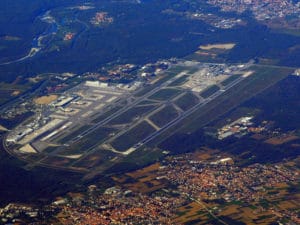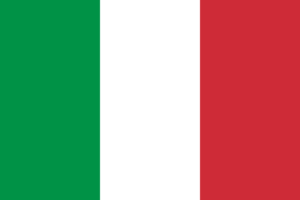Italy is one of the countries with the most vehicles per capita, with 690 per 1000 people in 2010. The national inland waterways network comprised 2,400 km (1,491 mi) of navigable rivers and channels for various types of commercial traffic in 2012.
Italy’s largest airline is Alitalia, which serves 97 destinations (as of October 2019) and also operates a regional subsidiary under the Alitalia CityLiner brand. The country also has regional airlines (such as Air Dolomiti), low-cost carriers, and Charter and leisure carriers (including Neos, Blue Panorama Airlines and Poste Air Cargo). Major Italian cargo operators are Alitalia Cargo and Cargolux Italia.
Italy is the fifth in Europe by number of passengers by air transport, with about 148 million passengers or about 10% of the European total in 2011. In 2012 there were 130 airports in Italy, including the two hubs of Malpensa International in Milan and Leonardo da Vinci International in Rome.

In 2004 there were 43 major seaports, including the seaport of Genoa, the country’s largest and second largest in the Mediterranean Sea. In 2005 Italy maintained a civilian air fleet of about 389,000 units and a merchant fleet of 581 ships.
Flag of Italy:
The flag of Italy, often referred to in Italian as il Tricolore; is a tricolor featuring three equally sized vertical pales of green, white and red, with the green at the hoist side. Its current form has been in use since 18 June 1946 and was formally adopted on 1 January 1948.

The Tricolour Day, Flag Day dedicated to the Italian flag, is established by law n. 671 of 31 December 1996, which is held every year on 7 January. This celebration commemorates the first official adoption of the tricolor as a national flag by the Cispadane Republic, a Napoleonic sister republic of Revolutionary France, which took place in Reggio Emilia on 7 January 1797. The Italian national colors appeared for the first time in Genoa on a tricolor cockade on 21 August 1789, anticipating by seven years the first green, white and red Italian military war flag, which was adopted by the Lombard Legion on 11 October 1796.
The Cispadane Republic supplanted the Duchy of Milan after Napoleon’s victorious army crossed Italy in 1796. The colors chosen by the Cispadane Republic were red and white, which were the colors of the flag of recently conquered Milan, and green, which was the color of the uniform of the Milanese civic guard. During this time, many small French-proxy republics of Jacobin inspiration supplanted the ancient absolute Italian states and almost all, with variants of color, used flags characterized by three bands of equal size, clearly inspired by the French model of 1790.
After the date of 7 January 1797 the popular consideration for the Italian flag grew steadily, until it became one of the most important symbols of the Risorgimento, which culminated on 17 March 1861 with the proclamation of the Kingdom of Italy, of which the tricolor rose to national flag. Since its adoption, the tricolor has become one of most recognizable and defining features of united Italian statehood in the following two centuries of history of Italy.
